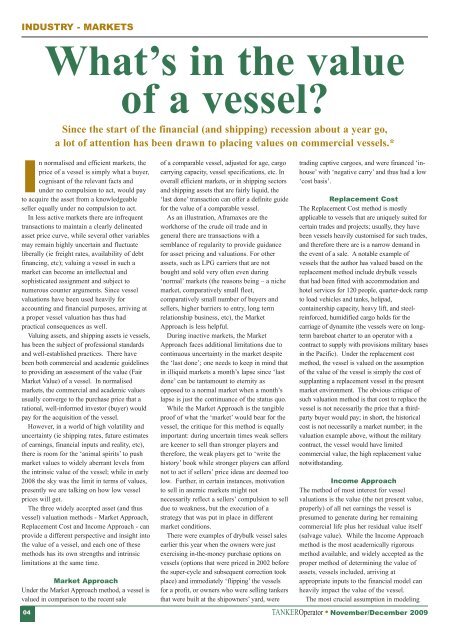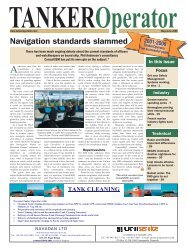Features: - Tanker Operator
Features: - Tanker Operator
Features: - Tanker Operator
You also want an ePaper? Increase the reach of your titles
YUMPU automatically turns print PDFs into web optimized ePapers that Google loves.
INDUSTRY - MARKETS<br />
What’s in the value<br />
of a vessel?<br />
Since the start of the financial (and shipping) recession about a year go,<br />
a lot of attention has been drawn to placing values on commercial vessels.*<br />
In normalised and efficient markets, the<br />
price of a vessel is simply what a buyer,<br />
cognisant of the relevant facts and<br />
under no compulsion to act, would pay<br />
to acquire the asset from a knowledgeable<br />
seller equally under no compulsion to act.<br />
In less active markets there are infrequent<br />
transactions to maintain a clearly delineated<br />
asset price curve, while several other variables<br />
may remain highly uncertain and fluctuate<br />
liberally (ie freight rates, availability of debt<br />
financing, etc); valuing a vessel in such a<br />
market can become an intellectual and<br />
sophisticated assignment and subject to<br />
numerous counter arguments. Since vessel<br />
valuations have been used heavily for<br />
accounting and financial purposes, arriving at<br />
a proper vessel valuation has thus had<br />
practical consequences as well.<br />
Valuing assets, and shipping assets ie vessels,<br />
has been the subject of professional standards<br />
and well-established practices. There have<br />
been both commercial and academic guidelines<br />
to providing an assessment of the value (Fair<br />
Market Value) of a vessel. In normalised<br />
markets, the commercial and academic values<br />
usually converge to the purchase price that a<br />
rational, well-informed investor (buyer) would<br />
pay for the acquisition of the vessel.<br />
However, in a world of high volatility and<br />
uncertainty (ie shipping rates, future estimates<br />
of earnings, financial inputs and reality, etc),<br />
there is room for the ‘animal spirits’ to push<br />
market values to widely aberrant levels from<br />
the intrinsic value of the vessel; while in early<br />
2008 the sky was the limit in terms of values,<br />
presently we are talking on how low vessel<br />
prices will get.<br />
The three widely accepted asset (and thus<br />
vessel) valuation methods - Market Approach,<br />
Replacement Cost and Income Approach - can<br />
provide a different perspective and insight into<br />
the value of a vessel, and each one of these<br />
methods has its own strengths and intrinsic<br />
limitations at the same time.<br />
Market Approach<br />
Under the Market Approach method, a vessel is<br />
valued in comparison to the recent sale<br />
04<br />
of a comparable vessel, adjusted for age, cargo<br />
carrying capacity, vessel specifications, etc. In<br />
overall efficient markets, or in shipping sectors<br />
and shipping assets that are fairly liquid, the<br />
‘last done’ transaction can offer a definite guide<br />
for the value of a comparable vessel.<br />
As an illustration, Aframaxes are the<br />
workhorse of the crude oil trade and in<br />
general there are transactions with a<br />
semblance of regularity to provide guidance<br />
for asset pricing and valuations. For other<br />
assets, such as LPG carriers that are not<br />
bought and sold very often even during<br />
‘normal’ markets (the reasons being – a niche<br />
market, comparatively small fleet,<br />
comparatively small number of buyers and<br />
sellers, higher barriers to entry, long term<br />
relationship business, etc), the Market<br />
Approach is less helpful.<br />
During inactive markets, the Market<br />
Approach faces additional limitations due to<br />
continuous uncertainty in the market despite<br />
the ‘last done’; one needs to keep in mind that<br />
in illiquid markets a month’s lapse since ‘last<br />
done’ can be tantamount to eternity as<br />
opposed to a normal market when a month’s<br />
lapse is just the continuance of the status quo.<br />
While the Market Approach is the tangible<br />
proof of what the ‘market’ would bear for the<br />
vessel, the critique for this method is equally<br />
important: during uncertain times weak sellers<br />
are keener to sell than stronger players and<br />
therefore, the weak players get to ‘write the<br />
history’ book while stronger players can afford<br />
not to act if sellers’ price ideas are deemed too<br />
low. Further, in certain instances, motivation<br />
to sell in anemic markets might not<br />
necessarily reflect a sellers’ compulsion to sell<br />
due to weakness, but the execution of a<br />
strategy that was put in place in different<br />
market conditions.<br />
There were examples of drybulk vessel sales<br />
earlier this year when the owners were just<br />
exercising in-the-money purchase options on<br />
vessels (options that were priced in 2002 before<br />
the super-cycle and subsequent correction took<br />
place) and immediately ‘flipping’ the vessels<br />
for a profit, or owners who were selling tankers<br />
that were built at the shipowners’ yard, were<br />
trading captive cargoes, and were financed ‘inhouse’<br />
with ‘negative carry’ and thus had a low<br />
‘cost basis’.<br />
Replacement Cost<br />
The Replacement Cost method is mostly<br />
applicable to vessels that are uniquely suited for<br />
certain trades and projects; usually, they have<br />
been vessels heavily customised for such trades,<br />
and therefore there are is a narrow demand in<br />
the event of a sale. A notable example of<br />
vessels that the author has valued based on the<br />
replacement method include drybulk vessels<br />
that had been fitted with accommodation and<br />
hotel services for 120 people, quarter-deck ramp<br />
to load vehicles and tanks, helipad,<br />
containership capacity, heavy lift, and steelreinforced,<br />
humidified cargo holds for the<br />
carriage of dynamite (the vessels were on longterm<br />
bareboat charter to an operator with a<br />
contract to supply with provisions military bases<br />
in the Pacific). Under the replacement cost<br />
method, the vessel is valued on the assumption<br />
of the value of the vessel is simply the cost of<br />
supplanting a replacement vessel in the present<br />
market environment. The obvious critique of<br />
such valuation method is that cost to replace the<br />
vessel is not necessarily the price that a thirdparty<br />
buyer would pay; in short, the historical<br />
cost is not necessarily a market number; in the<br />
valuation example above, without the military<br />
contract, the vessel would have limited<br />
commercial value, the high replacement value<br />
notwithstanding.<br />
Income Approach<br />
The method of most interest for vessel<br />
valuations is the value (the net present value,<br />
properly) of all net earnings the vessel is<br />
presumed to generate during her remaining<br />
commercial life plus her residual value itself<br />
(salvage value). While the Income Approach<br />
method is the most academically rigorous<br />
method available, and widely accepted as the<br />
proper method of determining the value of<br />
assets, vessels included, arriving at<br />
appropriate inputs to the financial model can<br />
heavily impact the value of the vessel.<br />
The most crucial assumption in modeling<br />
TANKER<strong>Operator</strong> November/December 2009

















